Hunterbrook Media’s investment affiliate, Hunterbrook Capital, does not have any positions related to this article at the time of publication. Positions may change at any time. Full disclosures below.
The Signal chats were only the start.
The American military has quietly built up forces in the Middle East to levels not seen since the War in Afghanistan, as Yemen’s government reportedly prepares for an offensive with 80,000 soldiers.
The alleged target: Hodeidah, a strategic port city and Houthi stronghold, from which militants have repeatedly attacked ships in the Red Sea.
Hunterbrook Media’s investigation of flight tracking data, satellite imagery, and military communications shows a fivefold surge in U.S. military cargo flights since March; strategic bomber deployments; and advanced missile defense systems being positioned throughout the region.
The accumulation of force appeared to go largely under the radar amid headlines about tariffs, the Ukraine war, and looming authoritarianism — until late last night when The Wall Street Journal scooped the story. Yemeni and U.S. officials told the paper that U.S. strikes on Yemen had paved the way for an “opportunity to oust the Houthis from at least parts of the Red Sea coast they have controlled in the decade since they took power over much of the country’s northwest.” This mirrored reporting from Emirati state media.
On Monday, regional media reported 15 airstrikes from U.S. warplanes in Ragwan and Madghal, bringing the total number of strikes to over 350 since March 15. The strike campaign continued after U.S. Central Command Commander Gen. Michael Erik Kurilla met with Yemeni Armed Forces Chief of Staff Lt. Gen. Sagheer Hamoud Ahmed Aziz in Saudi Arabia earlier this month.
A decision on whether the U.S. will support a ground operation against the Houthis “hasn’t been made yet,” according to officials who spoke with the Journal.
The looming conflict between Yemeni militias and the Iran-backed Houthis also comes amid nuclear talks between the United States and Iran, which are set to resume over the weekend.
The Military Aircraft Surge
Over the past month, U.S. military cargo flights landing at Middle Eastern airbases have jumped by nearly 400% “Hunterbrook recorded 10 flights in the period between 3/10 and 3/15, while 4/4 to 4/9 saw a total of 48 flights, representing a 380% increase.” , coinciding with an escalation of American airstrikes targeting Houthi positions in Yemen.
Hunterbrook used a combination of Automatic Dependent Surveillance–Broadcast (ADS-B) data from ADS-B Exchange and Aircraft Communications Addressing and Reporting System (ACARS) data from Airframes.io to track hundreds of U.S. Air Force transport aircraft operating in CENTCOM, including C-17 Globemaster IIIs, C-5 Galaxies, and KC-135 Stratotankers.
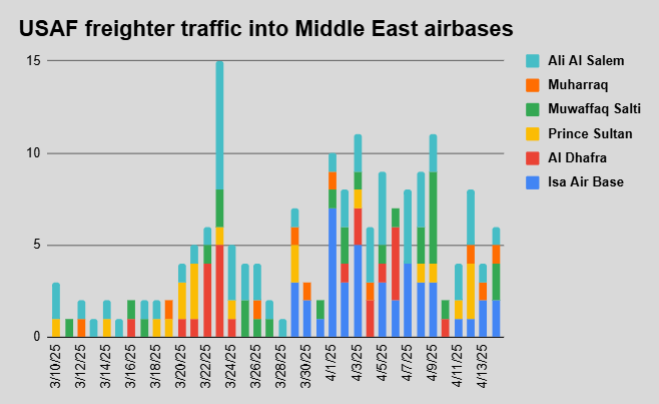
Early last week, dozens of messages began to fly between U.S. transport aircraft in South Korea. Almost all of the messages announced a common destination for the USAF C-17s: Isa Air Base in Bahrain.

A buildup at that location could be seen as part of U.S. efforts to pressure Iran during negotiations. On April 1, Middle East Eye reported that “Saudi Arabia, the UAE, Qatar, and Kuwait have all told the U.S.” that their air bases could not be used for a campaign against Iran.
Not on that list? The Kingdom of Bahrain, home to Isa Air Base.
“I think it’s primarily for the Houthis,” retired USAF Lt. Gen. Scott Howell, former commander of Joint Special Operations Command, told Hunterbrook. “I’d be very surprised if the U.S. did anything kinetic against Iran,” he said, but added: “What we consider prudent military planning, if you’re Iran, you probably view it as very provocative.”

Veena Ali-Khan, a Yemen and Persian Gulf analyst at the progressive Century Foundation, agreed. “The U.S. is more cautious with Iran than with the Houthis. Iran is less predictable, and Americans don’t want to cross certain red lines,” she said.
On April 4, Yonhap News confirmed that the U.S. was moving Patriot surface-to-air missile batteries from South Korea to the Middle East. The movement will include the most advanced interceptors in the U.S. arsenal, Patriot Advanced Capability-3 (PAC-3), capable of engaging and intercepting Iranian ballistic missiles, including the same variety used to target Israel in a pair of Iranian raids last year. This is reportedly the first transfer of U.S. Forces Korea assets to the Middle East.
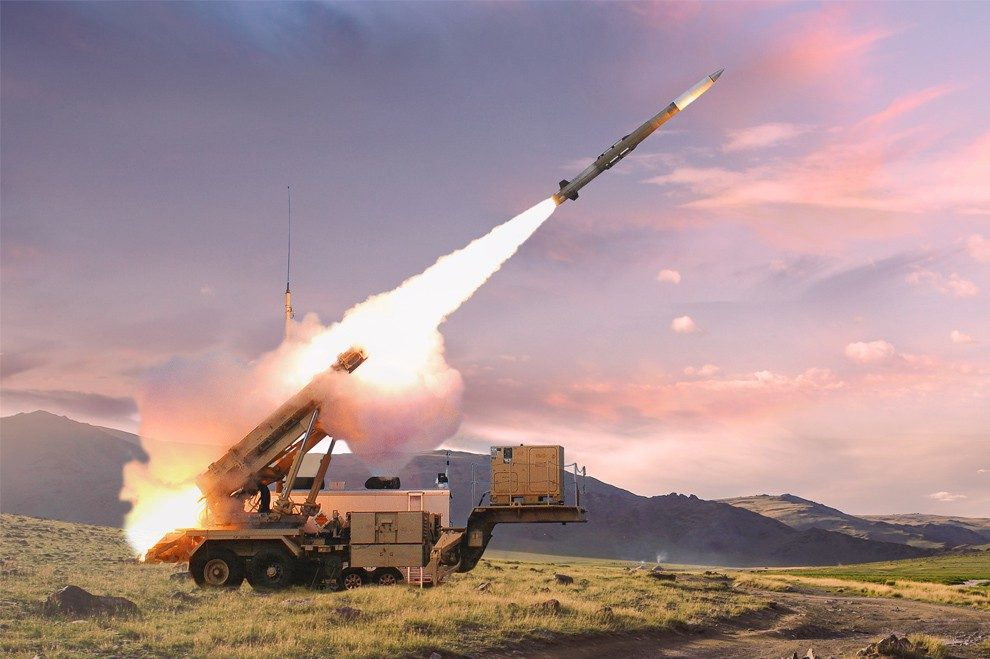
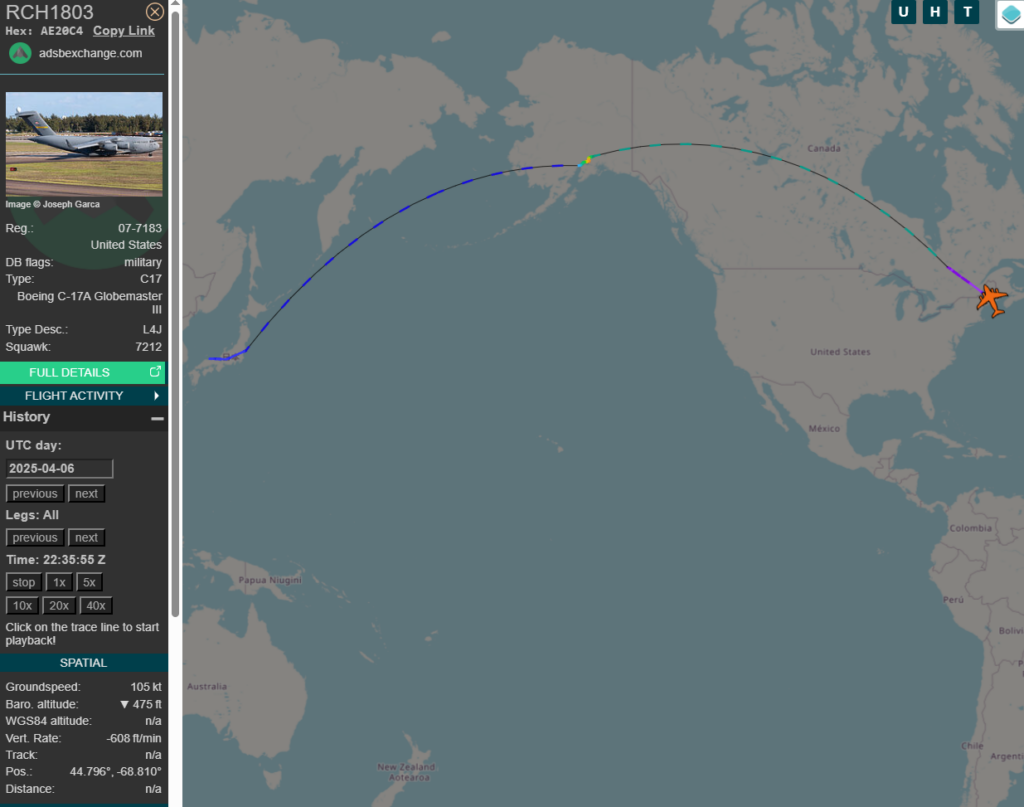

In testimony before the Senate Armed Services Committee on Thursday, Admiral Samuel Paparo, commander of U.S. Indo-Pacific Command, confirmed that the U.S. had moved an entire U.S. Army Patriot surface-to-air missile battalion from South Korea to CENTCOM. The transfer reportedly required 73 C-17 transport aircraft flights, accounting for roughly a third of those tracked by Hunterbrook.
The movement of an entire U.S. Army Patriot surface-to-air missile battalion represents a massive buildup of air defense assets in the region, accounting for roughly 7% of the Army’s total force. Based on known U.S. Army doctrine, the battalion should have anywhere from 96 to 384 ready-to-fire missiles, depending on its configuration.
(South Korean-based Patriot batteries usually deploy with eight M90X-series launchers, further increasing the potential missile load to 128-512.)
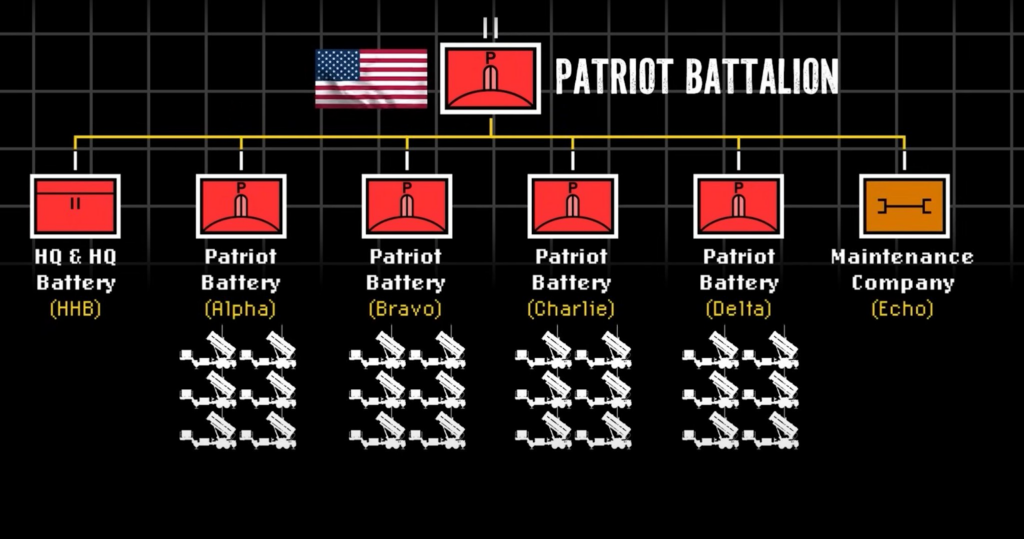
Notably, Admiral Paparo’s testimony suggested that the repositioning may have negatively impacted U.S. military readiness in Asia, occurring at a time when tensions between the United States and China have reached a critical level.
“Strengthening Integrated Air and Missile Defense (IAMD) in the Indo-Pacific depends on the deployment of capabilities such as Patriot and Terminal High Altitude Area Defense batteries. These IAMD systems, and others like them, provide a dual function: protecting key bases and infrastructure while enhancing regional deterrence.”
Diego Garcia
The fulcrum of the United States’ regional military buildup in the Indian Ocean is the small, isolated island of Diego Garcia. This British Indian Ocean Territory, leased to the United States for military purposes, serves as a vital operational hub projecting American power throughout the region.
Sitting on the tarmac since March 24 are six B-2 Spirit stealth bombers, half of the “fully operational” U.S. fleet. Reportedly, the aircraft have already been used to strike Houthi forces in Yemen.
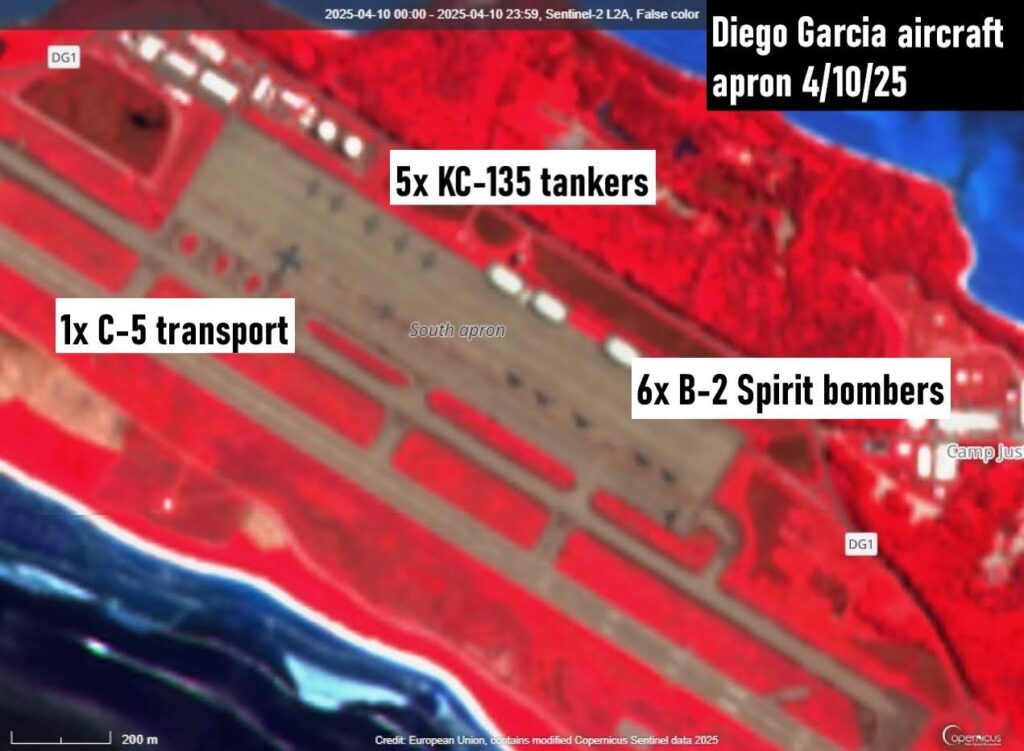
Each B-2 can carry one key capability that no other strike aircraft in the U.S. inventory can deploy: the GBU-57 MOP (Massive Ordnance Penetrator), a precision-guided, 30,000-pound “bunker buster” bomb. The MOP can penetrate over 200 feet into hardened targets, such as Iran’s Natanz Nuclear Enrichment Complex and Khorramabad Underground Missile Base, or the Houthi’s numerous underground weapons depots.
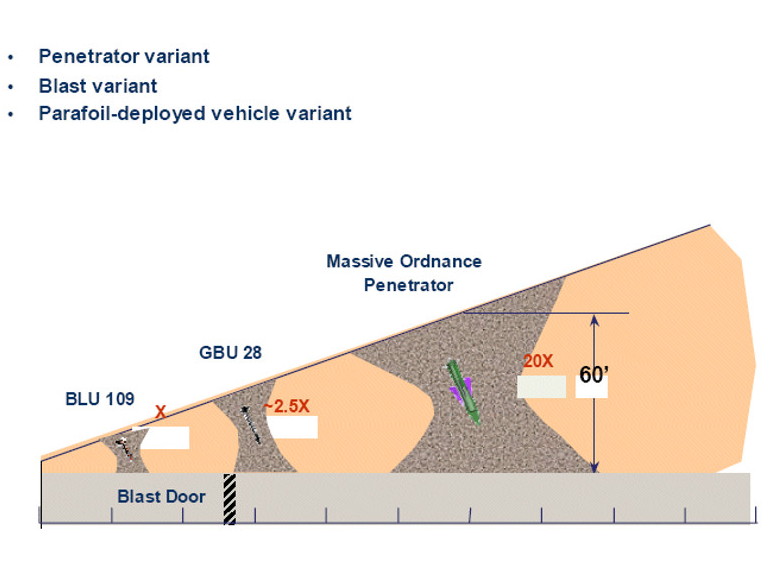
Each of the six B-2s sitting on the tarmac at Diego Garcia can carry two MOPs.
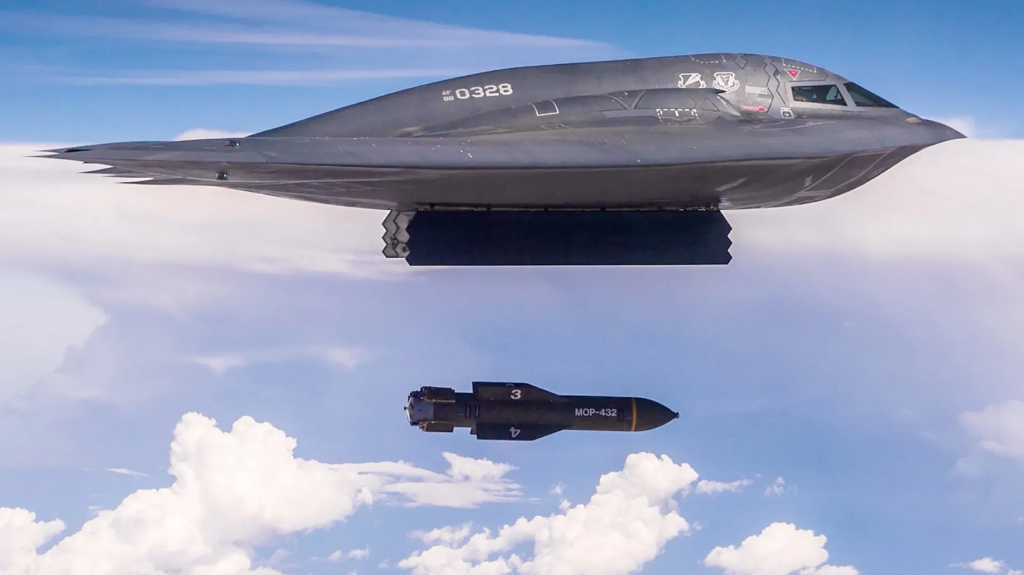
When asked if the jets “were meant to send a message to Iran,” Reuters reported, U.S. Secretary of Defense Pete Hegseth replied, “We’ll let them decide.”
Following reports that Iranian forces may target Diego Garcia, around April 4, the U.S. likely deployed at least one Arleigh Burke-class destroyer to the island, the USS Wayne E. Meyer (DDG-108).
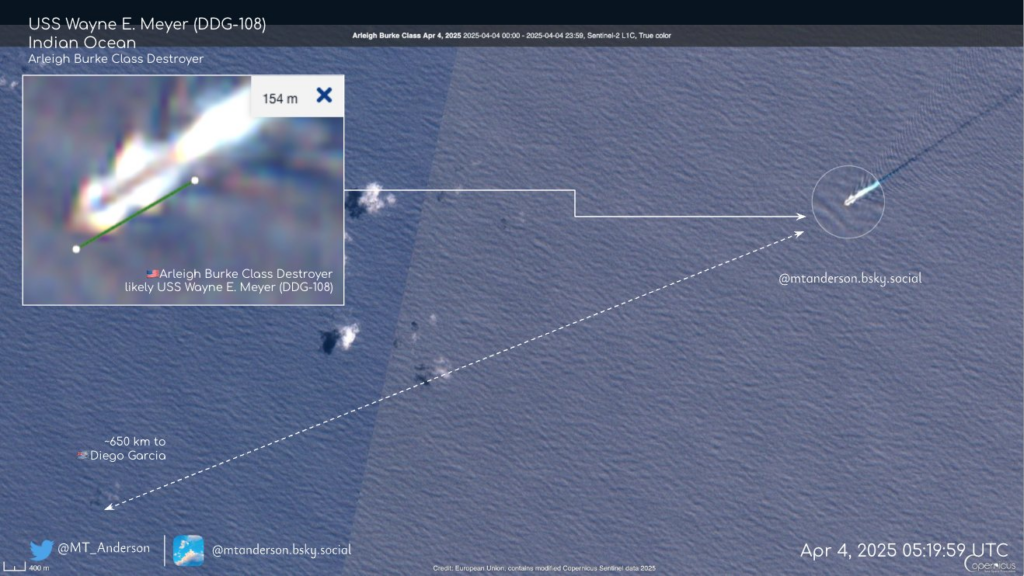
Multiple Iranian weapons systems do have the capability to target Diego Garcia, including ones that the U.S. Defense Intelligence Agency reports are in Houthi hands.
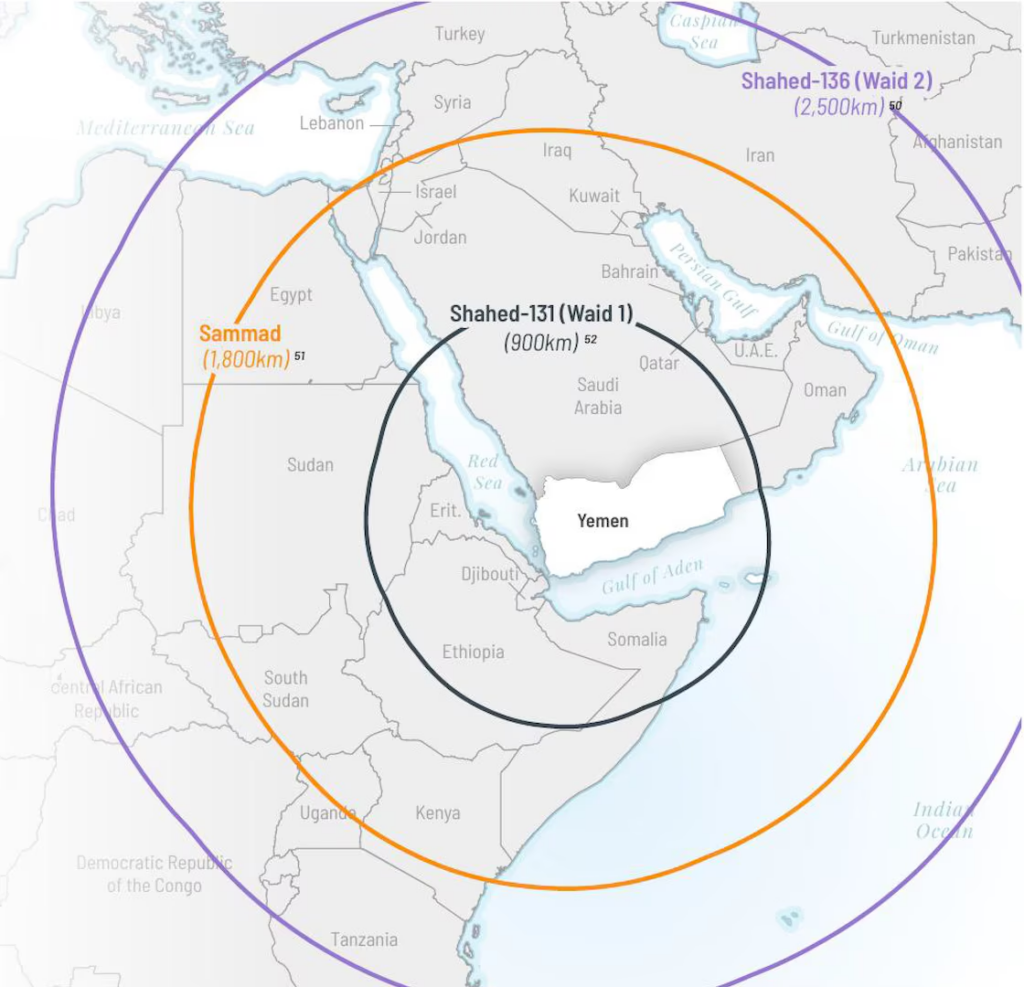
The B-2s at Diego Garcia did not come alone, arriving with nearly two dozen tankers and other cargo aircraft to support their deployment to the island.
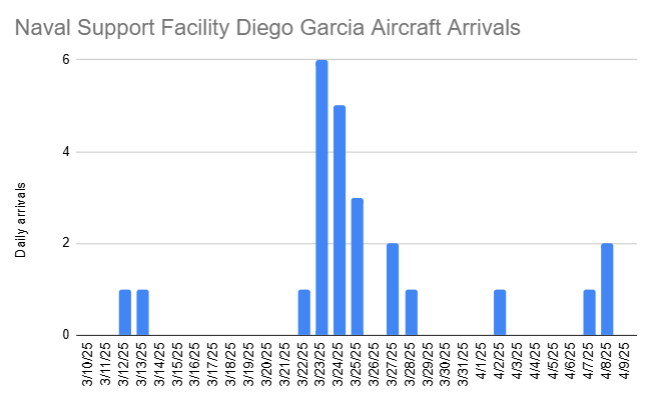
Source Lockdown
In recent days, the European Space Agency (ESA) has begun imposing limitations on publicly accessible satellite imagery covering Yemen. This move significantly curtails the availability of detailed, open-source intelligence previously used by independent researchers, humanitarian groups, and journalists to track the conflict in Yemen.
The limitations appear to have come into effect sometime around April. Multiple open-source researchers have commented on the censorship, expressing surprise.

Hunterbrook reached out to ESA for comment, but did not hear back by the time of publication.
A Naval Flotilla
Today, the U.S. Navy maintains two aircraft carriers actively deployed in the Middle East, with a third prepared to deploy on short notice. The last known occurrence of a dual-carrier deployment in the region took place in September 2024 — a period marked by intense hostilities, including active conflict between Israel and Hezbollah, Israel’s pager strike, the September 27 assassination of Hassan Nasrallah, and the imminent threat of a second Iranian attack on Israeli territory.
Currently, the USS Harry S. Truman (CVN-75) is anchoring the U.S. strike campaign targeting the Houthis. The carrier has been deployed since September 23, 2024, and has been operating in the Red Sea since December 14. The ship was forced to temporarily pull into Crete for repairs after accidentally colliding with a merchant ship near Port Said, Egypt.
Days ago, the USS Carl Vinson (CVN-70) arrived near Iran after a dash from the Pacific that started last week. Among the dozens of older F/A-18E/F Super Hornet strike fighters, the Vinson carries the “Warhawks” of VFA-97, equipped with the Navy’s newest stealth fighter: the F-35C. Alongside Truman, the U.S. now has a pair of carrier strike groups operating in the Middle East.
Hunterbrook was able to locate the Vinson operating in the Arabian Sea on the afternoon of April 14, less than 1000 miles from Houthi-controlled territory.

A third carrier, the USS Gerald R. Ford, may also be preparing to deploy to the Middle East
According to the USNI: “Aircraft carrier USS Gerald R. Ford (CVN-78) departed Norfolk, Va., March 14, according to ship spotters. The carrier is in the midst of its pre-deployment exercises.”
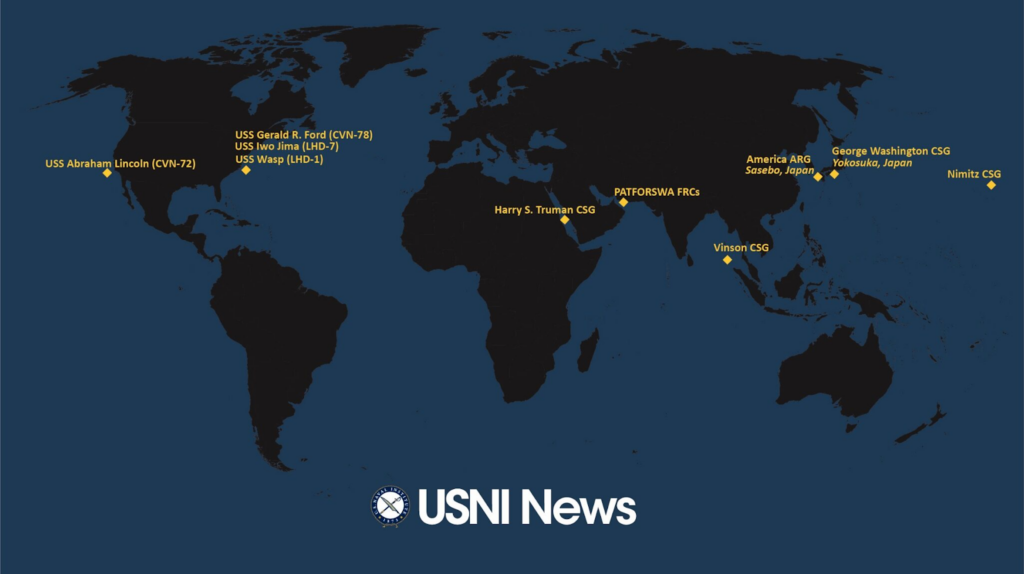
Satellite imagery indicates that the Ford has been at sea in the Atlantic for at least a month, reportedly taking part in COMPUTEX — a “certification exercise conducted during the integrated phase of the Optimized Fleet Response Plan.” It usually lasts “several weeks,” “during which units are tested on their proficiency and readiness through scenario-based, live training, that increases in complexity and intensity.”
One image released by the Navy shows the Ford, the Arleigh Burke-class guided-missile destroyer USS Winston S. Churchill (DDG 81), and the U.S. Coast Guard Cutter (USCGC) James (WMSL 754) cruising in the Atlantic on April 2. The Ford can be seen sporting a full air wing complement, with at least 22 Super Hornets sitting on deck.

On the night of April 10, newly sworn-in Secretary of the Navy John C. Phelan visited the Ford at sea, posting onboard footage with the message: “Last night I witnessed first hand the crew of USS Gerald R. Ford’s unmatched ability to conduct continuous combat operations at all hours.”
Based on AIS tracking data for USCGC, James, and ADS-B, the Ford has most likely been operating off the coast of Georgia for the last week with a full air wing complement. Barring some major engineering casualty, the Ford is capable of transiting to the Middle East in under a week.
It would be the first time since the Iraq War that three carriers were deployed to the region.
A Possible Ground War in Yemen
Yemeni government forces have reportedly begun preparing a significant military offensive striking into Houthi-controlled territory.
An attempt to retake a port like Hodeidah, a critical node in the Houthi effort to disrupt Red Sea shipping, would represent a major shift in the ongoing conflict — one that would almost certainly trigger swift retaliation by Houthi forces.
“The Houthis will continue to pose a serious threat to international shipping until they are deterred from doing so. Deterrence can only be achieved by rendering the Houthis unable or unwilling to continue their attacks. An air campaign could achieve deterrence, but it is unlikely to prevent the Houthis from conducting attacks,” says Brian Carter, the Middle East Portfolio Manager at the conservative American Enterprise Institute’s Critical Threats Project.
Carter continued, “The Houthis could decide to fire their missiles at Saudi oil and gas in response to renewed government military operations — which would increase energy prices — but the Houthis could also fire missiles at Saudi oil and gas for any other real or imagined threat in the future.”
Ali-Khan claimed the United Arab Emirates “thinks now is the best time for any kind of military offensive in the west coast, but they want guarantees that the U.S. will provide air support. They are counting on the Houthis to escalate to the point that the Americans have no choice but to support an offensive.”
The Saudis, she says, “don’t want anything to do with the military offensive in Yemen, for now.”

Equipped with advanced long-range drones and missile systems, the Houthis have previously demonstrated their capability and willingness to strike deep into Saudi territory, including critical infrastructure such as oil facilities and airports.
Such counterattacks could significantly escalate tensions, potentially expanding the conflict to neighboring Gulf states and disrupting global energy markets. In early 2021, a series of Houthi drone attacks targeted Saudi oil facilities, driving oil prices up to more than $70 per barrel. In 2019, Houthi forces successfully struck two Saudi Aramco plants, reportedly impacting over 5 million barrels per day of crude production.
In one of the now notorious leaked Signal group chat messages about earlier strikes against the Houthis, Vice President JD Vance suggested the U.S. should “minimize the risk to Saudi oil facilities.”
In the weeks that followed, Saudi Arabia and other OPEC+ members announced an accelerated plan to increase oil production, injecting an additional 411,000 barrels per day into the global market starting in May. Against the backdrop of tariffs, which themselves sent oil prices plummeting, the timing of the decision was seen as strange.
With the U.S. military build up in the region, a looming ground war, and potential Houthi counterstrikes, the surge in oil production makes just a bit more sense.
Author
Blake Spendley joined Hunterbrook from the Center for Naval Analyses (CNA), where he led investigations as a Research Specialist for the Marine Corps and US Navy. He built and owns the leading open-source intelligence (OSINT) account on X/Twitter, called @OSINTTechnical (>925K followers), which now distributes Hunterbrook Media content. His OSINT research has been published in Bloomberg, the Wall Street Journal, and The Economist, among other top business outlets. He has a BA in Political Science from USC.
Editor
Sam Koppelman is a New York Times best-selling author who has written books with former United States Attorney General Eric Holder and former United States Acting Solicitor General Neal Katyal. Sam has published in the New York Times, Washington Post, Boston Globe, Time Magazine, and other outlets — and occasionally volunteers on a fire speech for a good cause. He has a BA in Government from Harvard, where he was named a John Harvard Scholar and wrote op-eds like “Shut Down Harvard Football,” which he tells us were great for his social life. Sam is based in New York.
Hunterbrook Media publishes investigative and global reporting — with no ads or paywalls. When articles do not include Material Non-Public Information (MNPI), or “insider info,” they may be provided to our affiliate Hunterbrook Capital, an investment firm which may take financial positions based on our reporting. Subscribe here. Learn more here.
LEGAL DISCLAIMER
© 2025 by Hunterbrook Media LLC. When using this website, you acknowledge and accept that such usage is solely at your own discretion and risk. Hunterbrook Media LLC, along with any associated entities, shall not be held responsible for any direct or indirect damages resulting from the use of information provided in any Hunterbrook publications. It is crucial for you to conduct your own research and seek advice from qualified financial, legal, and tax professionals before making any investment decisions based on information obtained from Hunterbrook Media LLC. The content provided by Hunterbrook Media LLC does not constitute an offer to sell, nor a solicitation of an offer to purchase any securities. Furthermore, no securities shall be offered or sold in any jurisdiction where such activities would be contrary to the local securities laws.
Hunterbrook Media LLC is not a registered investment advisor in the United States or any other jurisdiction. We strive to ensure the accuracy and reliability of the information provided, drawing on sources believed to be trustworthy. Nevertheless, this information is provided "as is" without any guarantee of accuracy, timeliness, completeness, or usefulness for any particular purpose. Hunterbrook Media LLC does not guarantee the results obtained from the use of this information. All information presented are opinions based on our analyses and are subject to change without notice, and there is no commitment from Hunterbrook Media LLC to revise or update any information or opinions contained in any report or publication contained on this website. The above content, including all information and opinions presented, is intended solely for educational and information purposes only. Hunterbrook Media LLC authorizes the redistribution of these materials, in whole or in part, provided that such redistribution is for non-commercial, informational purposes only. Redistribution must include this notice and must not alter the materials. Any commercial use, alteration, or other forms of misuse of these materials are strictly prohibited without the express written approval of Hunterbrook Media LLC. Unauthorized use, alteration, or misuse of these materials may result in legal action to enforce our rights, including but not limited to seeking injunctive relief, damages, and any other remedies available under the law.
